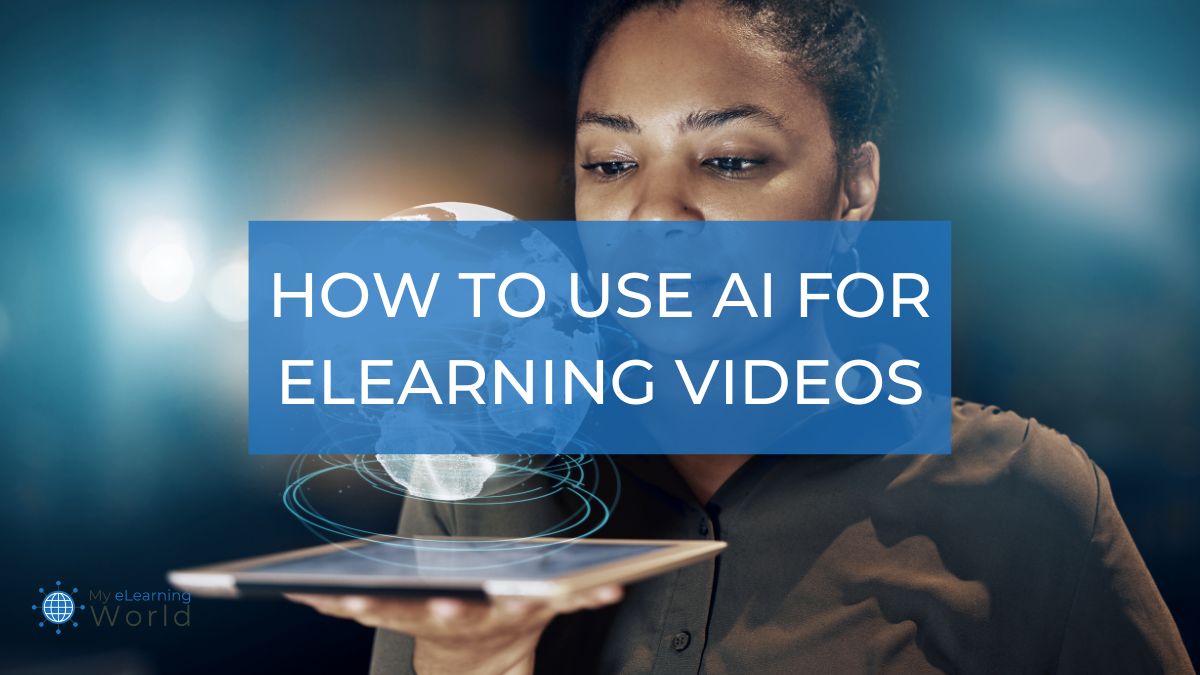Whether you create training videos for a small startup or an international enterprise, AI is reshaping the way we teach and learn. eLearning developers can use AI to streamline their processes, save time and money, engage learners and provide feedback, and reach a wider audience of learners around the world.
In this article, I’ll explore just a few of the ways you can use AI to take your eLearning videos to the next level.
How to Use AI for Your eLearning Videos
1. Automatically Add Subtitles
Adding subtitles is an essential part of the eLearning video production process.
Subtitles improve learner engagement and make it possible for viewers to utilize eLearning videos even when they don’t have access to audio.
Plus, subtitles are an important tool for those who have hearing impairments, or for international audiences who may need to read the captions in order to better understand the content.
In fact, studies have shown that almost 70% of publicly viewed videos have the sound off – so without subtitles, you’re likely to lose a lot of potential interest in your videos.
Creating subtitles used to require time-consuming sessions of listening and transcribing content once a video was otherwise completed. This process would often add extra hours into the already time-consuming process of publishing an eLearning video.
Thanks to AI, however, you can now create your subtitles instantaneously.
My favorite video editing tool VEED includes automated subtitle capabilities for over 700 minutes of video content, depending on the subscription tier you choose. Just activate the AI-enhanced subtitle option and watch the captions roll out in real time.
 VEED - Edit, Record & Livestream Video - Online
VEED - Edit, Record & Livestream Video - Online
VEED is the fastest and easiest way to make high quality, professional videos for eLearning, business training, sales presentations, and other applications.
Creators using VEED (review) can pick from a variety of fonts and formats to find the caption style that best suits their eLearning video’s needs.
AI-powered subtitles are far more accurate than the closed captions of yesteryear, too.
Thanks to Natural Language Processing, modern AI can quickly adjust to your speaker’s voice and generate an accurate reading of what they’re saying.
The fast turnaround and higher-quality end result earn AI-powered subtitles our top spot in terms of ways to improve your eLearning videos.
2. Change Languages on Demand
Another cool thing about AI-powered eLearning videos is the ease with which you can translate into different languages.
As companies become increasingly diversified across the globe, the ability to provide information in different languages is becoming a more valuable asset than ever.
Studies show that most learners would rather complete a required training in their native language, even if they’re competent at speaking English.
After all, learning something new is already challenging. Having to learn new skills in a second language adds another layer of complexity to the task.
Translation software has been around for awhile, but its accuracy has often been hit-or-miss. The number of languages available has also been spotty.
High quality translations would typically require the hiring of an outside expert, which can be expensive and time-consuming.
Now, however, you can translate your content into just about any language you choose with only a few clicks.
When using VEED, for example, users can choose from 125 different languages once they’ve created their eLearning videos.
The platform’s powerful AI translation service will create a 98.5% accurate translation within minutes.
Users can even select from a variety of stylish subtitles, so you can stay on-brand in every language.
The ability to present high-quality AI-powered translations for eLearning videos unlocks a literal world of potential, as it makes it possible to reach clients around the globe.
Smooth and correct translations can improve motivation and increase the effectiveness of your videos.
That’s why this powerful perk is our runner-up for one of the best ways to use AI to innovate your eLearning videos.
3. Save Time With Text-to-Speech
AI also boasts text-to-speech capabilities that you can use to eliminate the need to record voiceover narrations.
Simply provide the necessary text to go along with your video, and watch as an engaging voiceover is created for you in seconds!
Programs like VEED allow eLearning developers to incorporate automated text-to-speech, along with automatic subtitles and transcriptions for each video.
This adds to your eLearning video’s production value while cutting down on wasted time.
Automating time-consuming tasks like voiceovers allows you to put your energy to better uses, like designing engaging new content for your next video.
That’s why seamless text-to-speech capabilities are high on our list of AI-enhanced features we love.
4. Outsource Your Scriptwriting
My next recommended AI-feature involves letting chatbots write your scripts for you.
This is another excellent way to cut down on the tedious tasks and boost your productivity.
Large language model chatbots like ChatGPT are capable of creating engaging scripts for your videos and demos based on a few simple prompts.
These powerful tools have been exposed to vast amounts of content and are able to write surprisingly nuanced texts.
Choose the length, format, and tone of the script you need, then watch as AI creates a text to fit the parameters you’ve set in minutes.
Of course, I need to point out the importance of giving all of your AI-created scripts a quick read-through to make sure there are no errors or awkward phrases. While AI writing tools have come a long way, they’re still not perfect and sometimes write in a very stilted, unnatural way.
For folks who are responsible for generating huge quantities of scripts, though, taking a few minutes to proofread is far preferable to spending hours manually writing scripts.
Saving yourself time by letting AI do the brunt of your scriptwriting is a great way to make this powerful technology work in your favor.
5. Assess Success with Quizzes & Games
Scripts aren’t the only thing AI-powered tools can create. You can also use these tools to generate quick quizzes or games to include in your eLearning videos.
Sprinkling a few quiz questions throughout a learning module is a great way to build in accountability and help your learners keep tabs on their progress.
Drafting these questions can get time-consuming, however, and can pull your attention away from the more creative elements of instructional design.
Plus, having to grade these questions and provide feedback to your viewers can also place big demands on your time.
That’s where AI-automated quizzes can save the day.
Again, simply choose the question type you want (true/false, multiple choice, et cetera) and input the content you need assessed, and AI will take care of the rest.
Most AI-generated quizzes are also graded automatically, removing another time-consuming task from your list.
AI is also excellent for adding an element of gamification to your eLearning videos.
Some AI technology can even provide customized games based on your learner’s responses or interests, which increases motivation and learner buy-in.
Any good eLearning developer knows that assessment is an important part of training. Assessments help both the trainer and the trainee monitor progress and reach important goals.
Letting AI take over this element can save time and keep your content interesting and relevant for your learners, too.
Final Thoughts
These ideas are just the tip of the iceberg when it comes to harnessing the potential of AI for eLearning.
AI can streamline your video production process, make your videos more accessible to audiences around the world, and make your courses more engaging and interesting for learners.
While there’s no limit to the ways AI can innovate eLearning, the ideas above are a great way to get started!
Do you have experience using AI-enhanced video tools like VEED? Have any ideas on how AI can improve eLearning videos that we didn’t mention here? We’d love to hear them in the comments below!


